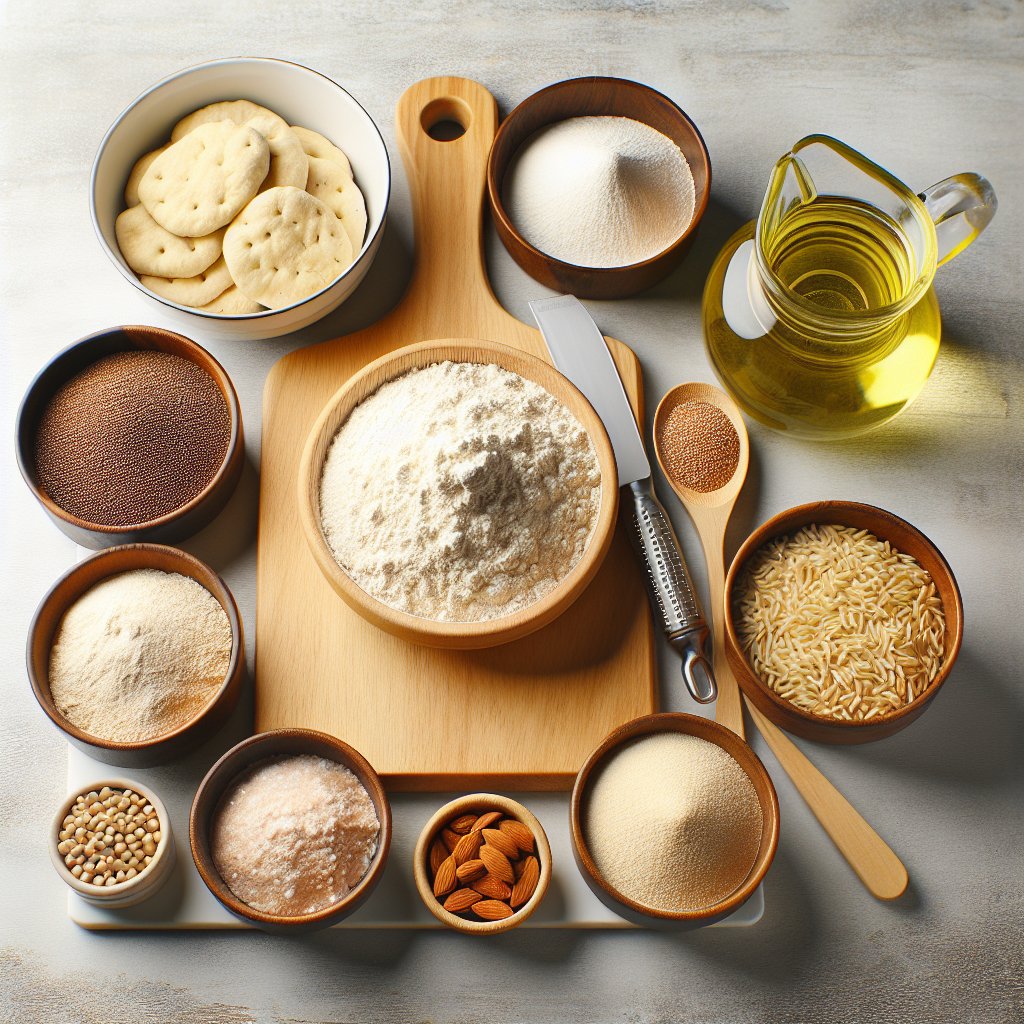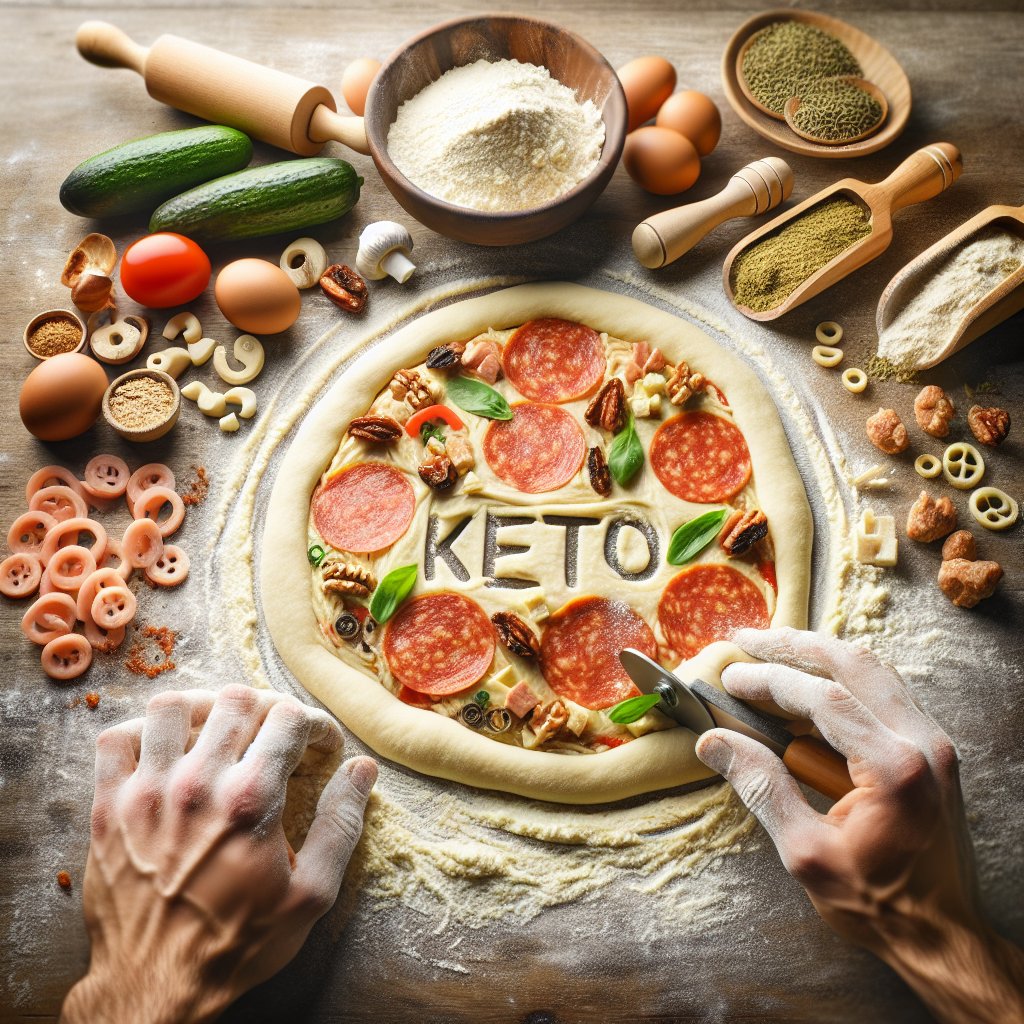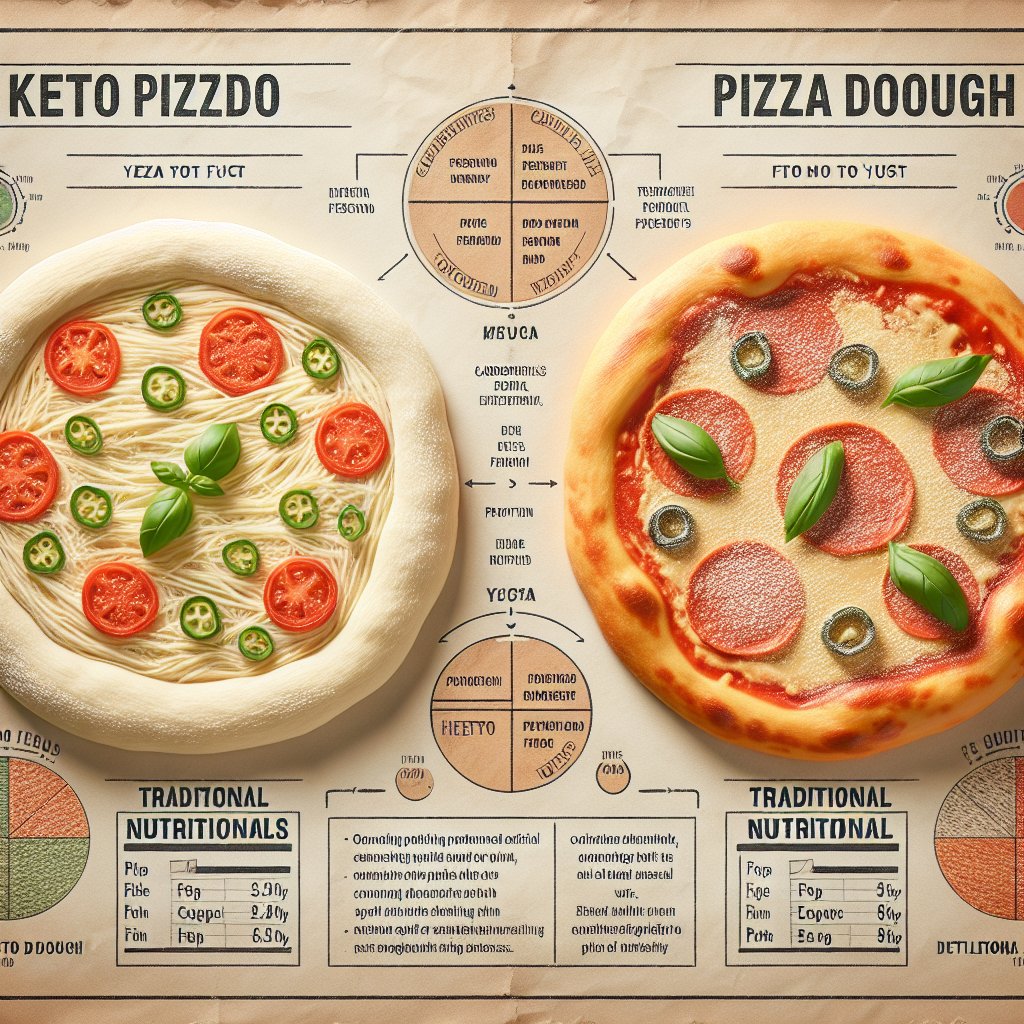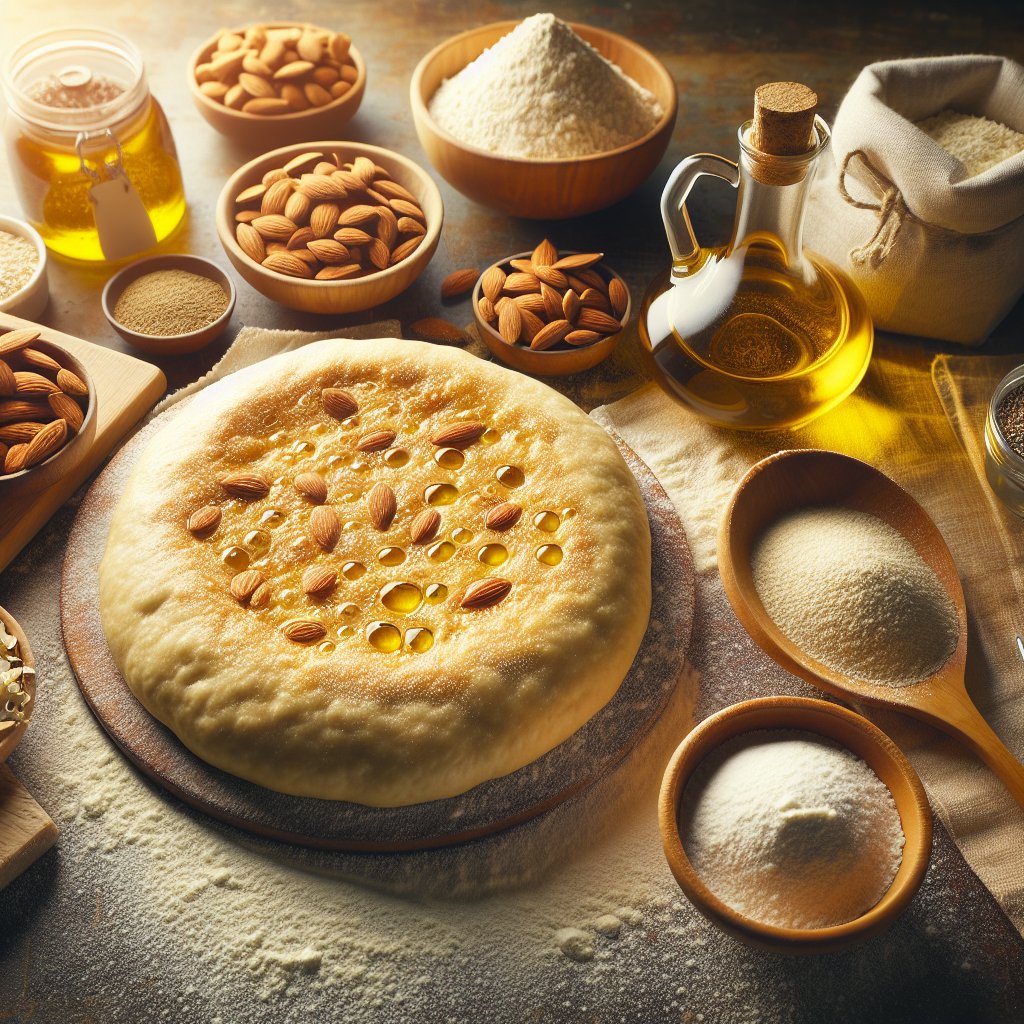Master the Keto Game with Our Ultimate Keto Pizza Dough Recipe with Yeast – Your Key to Low-Carb Pizza Perfection!
Brief Overview of the Popularity of Keto Diets
Hey there, fellow keto enthusiasts! Let’s talk about the current keto craze. The ketogenic diet has been gaining a significant amount of popularity in recent years, and for a good reason. This low-carb, high-fat diet has been shown to offer a wide range of health benefits, from weight loss to improved blood sugar control and increased mental clarity. It’s no wonder that so many people are jumping on the keto bandwagon!
But here’s the deal – following a keto diet doesn’t mean you have to sacrifice your favorite foods. It’s all about getting a little creative and finding delicious low-carb alternatives.
The Importance of a Good Keto Pizza Dough Recipe with Yeast
Now, let’s talk about something near and dear to many of our hearts – pizza. Yes, you can absolutely enjoy pizza on a keto diet, thanks to the magic of the right keto pizza dough recipe. And when it comes to creating a perfect keto pizza dough, the addition of yeast is a game-changer.
Yeast not only contributes to the fluffy texture and delicious flavor of the dough but also offers some surprising health benefits. Studies have shown that yeast may have a positive impact on gut health, thanks to its probiotic properties. Additionally, the inclusion of yeast in the dough may provide B vitamins and minerals, such as selenium, which are beneficial for overall health.
Moreover, the use of yeast in the keto pizza dough fermentation process can result in a lower glycemic index, meaning it may have a smaller impact on blood sugar levels compared to traditional pizza crusts.
So, ensuring you have a good keto pizza dough recipe with yeast is not only about taste and texture but also about enhancing the nutritional value of your favorite treat.

Understanding Keto Diet
So, you’ve decided to crush your health and fitness goals with the ketogenic diet. Awesome choice! For those who might not be familiar with it, the keto diet is a low-carb, high-fat eating plan that offers numerous health benefits. The main goal is to induce a state of ketosis, where your body switches from using carbohydrates as its primary source of fuel to burning fats instead. This metabolic state can lead to weight loss, improved energy levels, and enhanced mental focus.
Now, let’s talk about an essential aspect of the keto diet – low-carb pizza dough. We all love pizza, and the thought of giving it up while on the keto diet can be daunting. But fear not, because with the right low-carb pizza dough recipe using yeast, you can still indulge in this beloved comfort food without kicking yourself out of ketosis.
Traditional pizza dough is loaded with high-carb ingredients like flour, which doesn’t align with the principles of the keto diet. By switching to a low-carb pizza dough, you can satisfy your pizza cravings while keeping your carb intake in check.
Research has shown that reducing carbohydrate consumption can lead to greater weight loss compared to low-fat diets, making low-carb pizza dough an essential component of the keto lifestyle. A study published in the American Journal of Clinical Nutrition found that a low-carb diet can result in improved body composition and metabolic health.

Benefits of Using Yeast in Keto Pizza Dough
Yeast plays a crucial role in creating the perfect keto pizza dough. It’s not just about making the dough rise, but it also contributes to the overall texture and taste of the final product. Let’s dive into the benefits of using yeast in keto pizza dough and how it impacts the overall pizza experience.
Texture
When it comes to keto pizza dough, achieving the right texture can be a challenge. This is where yeast works its magic. Scientific research has shown that the addition of yeast to dough results in the production of carbon dioxide, which forms air pockets in the dough, leading to the characteristic airy and chewy texture that is highly desirable in pizza crusts. These air pockets contribute to the light and airy mouthfeel that is often lacking in non-yeast keto pizza dough.
Taste
Yeast also greatly influences the flavor profile of keto pizza dough. During the fermentation process, yeast produces various flavor compounds that give the dough a complex and satisfying taste. Studies have demonstrated that the compounds produced by yeast during fermentation are responsible for creating the distinct savory and slightly tangy flavor that is synonymous with traditional pizza crusts. This means that by using yeast in your keto pizza dough, you can achieve a more authentic and enjoyable pizza eating experience.
Furthermore, the slow fermentation process that occurs when using yeast also helps to develop a depth of flavor in the dough, enhancing the overall taste of the pizza crust.
So, if you’re aiming for a keto pizza dough that not only mimics the texture of traditional pizza crust but also maintains that classic pizza flavor profile, incorporating yeast is an absolute game-changer. The end result is a keto-friendly pizza crust that is both light and flavorful, satisfying even the most discerning pizza aficionados.

Key Ingredients for Keto Pizza Dough with Yeast
When it comes to creating the perfect keto pizza dough with yeast, the right ingredients are crucial for achieving that ideal texture and flavor. Here are the essential components you need to nail your low-carb pizza crust:
Almond Flour
The base of any good keto pizza dough is almond flour. Almond flour is not only low in carbs but also high in healthy fats and fiber, making it an excellent choice for a keto-friendly crust. Additionally, almond flour adds a slightly nutty flavor that complements the other ingredients in the dough.
Psyllium Husk Powder
Psyllium husk powder is a game-changer when it comes to keto dough. It provides the dough with a doughy, bread-like texture and helps hold everything together. This fiber-rich ingredient is also known for its digestive benefits and can contribute to the feeling of fullness, which is an added bonus for those following a ketogenic lifestyle.
Active Dry Yeast
For that traditional pizza dough flavor and rise, incorporating active dry yeast is essential. Yeast not only adds a distinctive taste and aroma to the crust but also contributes to the dough’s airy and light texture. It’s important to note that the yeast needs a sweetener to feed on, so using a keto-friendly sweetener like erythritol is recommended.
Eggs
Eggs act as a binding agent in keto pizza dough and help provide structure to the crust. They also contribute to the overall richness and moistness of the dough, resulting in a perfectly balanced final product.
With these key ingredients in your keto pantry, you’ll be well on your way to crafting a delectable pizza crust that satisfies your cravings while aligning with your low-carb lifestyle.

Step-by-Step Recipe Instructions
Are you ready to dive into the world of keto-friendly pizza? Let’s get started with our ultimate keto pizza dough recipe that includes yeast for the perfect texture and flavor. Follow these detailed instructions to create a low-carb pizza dough that will satisfy your pizza cravings while keeping you in ketosis.
Ingredients You’ll Need:
Before we get into the step-by-step instructions, let’s gather all the ingredients you will need for the perfect keto pizza dough with yeast:
– 1 ½ cups of almond flour
– 2 tsp of active dry yeast
– 1 tsp of sweetener (such as erythritol or stevia)
– 1 ½ cups of shredded mozzarella cheese
– 2 tbsp of cream cheese
– 2 ½ cups of almond flour
– 1 tsp of xanthan gum
– 2 large eggs
– 1 tsp of salt
– Your choice of keto-friendly toppings
Step 1: Activate the Yeast
Start by activating the yeast. In a small bowl, combine the active dry yeast, sweetener, and ¼ cup of warm water. Let the mixture sit for about 5-10 minutes until it becomes frothy. This step is crucial as it ensures that the yeast is alive and ready to leaven the dough.
Step 2: Melt the Cheese
Next, place the mozzarella cheese and cream cheese in a microwave-safe bowl. Microwave the cheeses for 1 minute, then stir, and microwave for another 30 seconds or until fully melted. If you don’t have a microwave, you can also melt the cheeses on the stovetop using a double boiler.
Step 3: Mix the Dough
In a large bowl, combine the almond flour, xanthan gum, and salt. Add the melted cheese, activated yeast mixture, and eggs to the dry ingredients. Using a hand mixer or your hands, mix the dough until all the ingredients are well combined and form a smooth dough ball.
Step 4: Let the Dough Rise
Place the dough ball in a greased bowl and cover it with a clean kitchen towel. Let it rise in a warm place for about 45-60 minutes. During this time, the yeast will work its magic, and the dough will increase in size.
Step 5: Preheat the Oven and Roll Out the Dough
Once the dough has risen, preheat your oven to 400°F (200°C). Place the dough on a piece of parchment paper and roll it out to your desired thickness. Remember, the thinner the crust, the crispier the pizza!
By following these step-by-step instructions, you can create a flavorful and satisfying keto pizza dough using yeast from scratch, setting the stage for a delicious low-carb pizza masterpiece.
Remember, the key to a successful keto pizza crust is to let the dough rise to achieve a light and airy texture while incorporating wholesome low-carb ingredients.
So, are you ready to embark on a keto pizza-making adventure? Let’s get cooking!

Tips for Perfecting Keto Pizza Dough
When it comes to creating the perfect keto pizza dough with yeast, there are a few essential tips and tricks to ensure the dough turns out well and achieves the desired texture.
Use High-Quality Ingredients
To achieve the best texture and flavor, it’s essential to use high-quality ingredients. Opt for almond flour, psyllium husk powder, and yeast, all of which play a crucial role in creating the ideal keto pizza dough. Additionally, using fresh, high-quality yeast will contribute to the dough’s rise and overall texture.
Properly Activate the Yeast
Activating the yeast is a critical step in ensuring your keto pizza dough rises properly. To activate the yeast, combine it with warm water and a small amount of low-carb sweetener, such as erythritol. Let it sit for a few minutes until the mixture becomes foamy. This foaming indicates that the yeast is active and ready to be added to the dough.
The Importance of Psyllium Husk Powder
Psyllium husk powder is a staple ingredient in many keto baking recipes, and for a good reason. It helps create a bread-like texture and helps bind the ingredients together. When making keto pizza dough with yeast, the psyllium husk powder plays a crucial role in achieving the desired dough consistency. Be sure to mix it thoroughly into the dough to avoid any clumps.
Don’t Overwork the Dough
When working with keto pizza dough, it’s important not to overwork it. Overworking the dough can lead to a tough and dense crust rather than the desired light and airy texture. Mix the ingredients until just combined, and then allow the dough to rest to develop the gluten structure.
Use a Pizza Stone or Pizza Steel
For the perfect keto pizza crust with yeast, using a pizza stone or pizza steel can make a significant difference. Preheat the stone or steel in the oven before baking the pizza to ensure a crispy crust. The heat retention properties of these tools help create an evenly baked crust with a delightful texture.
By following these tips and tricks, you can master the art of creating the ultimate keto pizza dough with yeast, resulting in a low-carb pizza crust that’s sure to impress!
Overall word count: 413

Guidance on Baking the Perfect Keto Pizza
Now that you’ve mastered the art of making the ultimate keto pizza dough with yeast, it’s time to bake your low-carb masterpiece. Baking the pizza dough properly is crucial to achieving that perfect crispy yet chewy crust that we all love. Here are some tips to ensure your keto pizza turns out just right.
Preheat and Pre-bake
Start by preheating your oven to the highest temperature possible, usually around 500°F (260°C). Place a pizza stone or baking sheet in the oven while it preheats. Pre-baking the crust for a few minutes before adding the toppings will help prevent a soggy crust, especially when using moist, low-carb sauce.
Thin and Even
Roll out the dough thinly and evenly to ensure it cooks through and achieves that desirable crispiness. Keep the edges slightly thicker to form a crust that holds the toppings without becoming limp.
Toppings to Enhance Flavor
Now, let’s talk toppings. While keeping it low-carb, you have a wide range of delicious options to enhance the flavor of your keto pizza. Consider using sugar-free marinara sauce, fresh mozzarella, and a variety of colorful vegetables such as bell peppers, spinach, and mushrooms. Crispy toppings like bacon, pepperoni, or even thinly sliced prosciutto can add a delightful crunch to each bite.
For a burst of fresh flavor, add basil leaves or arugula after the pizza is out of the oven. These toppings not only bring vibrant color to your pizza but also pack a flavorful punch without piling on extra carbs.
Don’t forget about the power of seasoning! A sprinkle of garlic powder, oregano, or red pepper flakes can take your keto pizza to the next level without adding unnecessary carbs.
By following these baking tips and selecting the right toppings, you can savor a delicious keto pizza while staying true to your low-carb lifestyle.

Nutritional Value of Keto Pizza Dough
Let’s break down the nutritional information of keto pizza dough and compare it to traditional pizza dough. This will give you a clear understanding of why keto pizza dough is a smart choice for your low-carb lifestyle.
Macronutrient Comparison
When it comes to macronutrients, keto pizza dough takes the lead. A 100-gram serving of keto pizza dough typically contains around 5 grams of net carbs, while the same amount of traditional pizza dough can pack a whopping 36 grams of net carbs. That’s a stark contrast! In addition, keto pizza dough is higher in fat and lower in carbs, aligning perfectly with the keto guidelines. This makes keto pizza dough a winning choice for those following a ketogenic diet.
Beneficial Fiber Content
Another crucial aspect is the fiber content. Keto pizza dough, often made with almond flour or coconut flour, contains a good amount of fiber. Fiber is essential for gut health and can aid in digestion. On the other hand, traditional pizza dough made with refined flour lacks significant fiber content. By choosing keto pizza dough, you’re not just cutting carbs but also increasing your fiber intake, which is a win-win for your digestive system.
Lower Calorie Count
Calorie-wise, keto pizza dough also has an edge. It’s generally lower in calories compared to traditional pizza dough. This means that by using keto pizza dough in your homemade pizzas, you’re not only reducing carb intake but also managing your calorie consumption, which can be beneficial for reaching and maintaining a healthy weight.
With such impressive nutritional credentials, keto pizza dough stands out as a wholesome, low-carb alternative to traditional pizza dough. Its macronutrient profile, fiber content, and lower calorie count make it a clear winner for anyone looking to enjoy a delicious pizza while staying faithful to their ketogenic lifestyle.

Addressing Common Questions About Keto Pizza Dough
When it comes to making keto pizza dough with yeast, there are several common questions that arise. Let’s address some of these FAQs and provide you with troubleshooting tips to ensure your low-carb pizza perfection!
Does yeast fit into a keto diet?
Yes, yeast can absolutely be a part of a keto diet. While it’s true that yeast is used to help the dough rise by consuming sugars, the majority of the sugars are consumed during the fermentation process. This means that the carb content of the dough is significantly reduced, making it suitable for a keto lifestyle.
What type of yeast should I use for keto pizza dough?
For the best results in your keto pizza dough, you can use instant or active dry yeast. Both types work well in low-carb pizza crusts. Be sure to check the expiration date and follow the instructions on the packaging for the amount to use in your dough.
How can I troubleshoot if my dough doesn’t rise?
If your keto pizza dough doesn’t rise as expected, there are a few troubleshooting tips you can try. First, ensure that your yeast is fresh and active. Additionally, letting the dough rise in a warm place can help activate the yeast. If all else fails, you might need to increase the temperature and moisture in your dough environment.
By understanding these common questions and troubleshooting tips, you’ll be well-equipped to master the art of making keto pizza dough with yeast and enjoy your low-carb pizza guilt-free!

Conclusion: Mastering the Art of Keto Pizza Dough Recipe with Yeast
As we wrap up our journey through the ultimate keto pizza dough recipe with yeast, it’s important to summarize the key points and emphasize the crucial role of a good keto pizza dough recipe in the overall success of a keto diet experience. We’ve delved into the science of ketogenic dieting, explored the benefits of yeast in keto pizza dough, and unraveled the secrets to achieving low-carb pizza perfection.
Summarizing the Key Points
Throughout this article, we’ve highlighted the significance of nutrition in a ketogenic lifestyle, emphasizing the need for low-carb, high-fat, and moderate-protein meals. Understanding the science behind ketosis has shown us that the body’s metabolism shifts to burning fat for fuel, offering various health benefits, including weight loss and improved blood sugar control. We’ve also examined the role of yeast in keto pizza dough, recognizing its ability to create a light, fluffy texture while keeping the carb content low. Additionally, we’ve uncovered the ultimate keto pizza dough recipe with yeast, leveraging the power of almond flour and vital wheat gluten to craft a delicious, keto-friendly pizza crust.
The Importance of a Good Keto Pizza Dough Recipe with Yeast
When it comes to navigating the delectable world of keto-friendly pizzas, the dough serves as the foundation for culinary success. A quality keto pizza dough recipe with yeast is paramount to achieving an authentic, satisfying pizza experience without compromising your dietary goals. By incorporating yeast into the dough, you not only elevate the texture, flavor, and aroma of the crust but also enhance its nutritional profile. The slow fermentation process of yeast contributes to the development of complex flavors and a desirable airy structure, mirroring the characteristics of traditional pizza crusts.
Moreover, having a go-to keto pizza dough recipe with yeast in your repertoire empowers you to indulge in a beloved comfort food while staying true to your low-carb, high-fat lifestyle. This not only eliminates feelings of deprivation but also fosters a sustainable approach to keto living, promoting long-term adherence and overall satisfaction. By mastering the art of keto pizza dough with yeast, you open the doors to a world of creative topping combinations, allowing you to customize your pizza to align with your taste preferences and nutritional needs.
In essence, the journey to mastering a good keto pizza dough recipe with yeast is an integral part of the overall keto experience. It serves as a delicious embodiment of balance, enabling you to savor the pleasures of pizza while reaping the rewards of a ketogenic diet.

Ultimate Keto Pizza Dough Recipe with Yeast
Servings: 4
Preparation time: 45 minutes
Ingredients:
| 2 cups almond flour |
| 1 tbsp psyllium husk powder |
| 2 tsp active dry yeast |
| 1/2 tsp salt |
| 1/2 tsp garlic powder |
| 1/2 tsp onion powder |
| 1/2 tsp Italian seasoning |
| 1/4 cup warm water |
| 2 tbsp olive oil |
| 1 large egg |
| 1 1/2 cups shredded mozzarella cheese |
| Toppings of your choice (e.g. sugar-free pizza sauce, low-carb vegetables, pepperoni, cheese) |
Instructions:
| 1. In a small bowl, dissolve the yeast in warm water with a pinch of sugar substitute. Let it sit for 5-10 minutes until it becomes frothy. |
| 2. In a large bowl, combine the almond flour, psyllium husk powder, salt, garlic powder, onion powder, and Italian seasoning. |
| 3. Add the olive oil, egg, and yeast mixture to the dry ingredients and mix well to form a dough. |
| 4. Fold in the shredded mozzarella cheese and knead the dough until it is smooth and well combined. |
| 5. Preheat the oven to 425°F (220°C) and line a baking sheet with parchment paper. |
| 6. Divide the dough into 4 equal parts and shape each portion into a pizza crust on the prepared baking sheet. |
| 7. Bake the pizza crusts in the preheated oven for 8-10 minutes until they start to turn golden brown. |
| 8. Remove the crusts from the oven and add your favorite low-carb pizza toppings. |
| 9. Return the pizzas to the oven and bake for an additional 5-7 minutes, or until the cheese is melted and bubbly. |
| 10. Slice and serve the keto pizza hot, and enjoy your low-carb pizza perfection! |
Nutrition facts:
| Calories per serving | 320 |
| Total Fat | 26g |
| Net Carbs | 4g |
| Protein | 15g |


